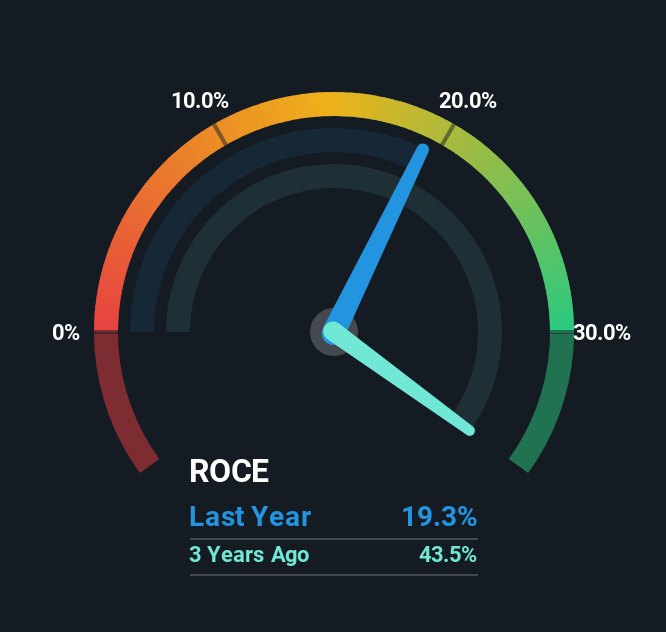- India
- /
- Construction
- /
- NSEI:HCC
Returns On Capital Signal Tricky Times Ahead For Hindustan Construction (NSE:HCC)
Did you know there are some financial metrics that can provide clues of a potential multi-bagger? Ideally, a business will show two trends; firstly a growing return on capital employed (ROCE) and secondly, an increasing amount of capital employed. Ultimately, this demonstrates that it's a business that is reinvesting profits at increasing rates of return. Although, when we looked at Hindustan Construction (NSE:HCC), it didn't seem to tick all of these boxes.
What Is Return On Capital Employed (ROCE)?
For those that aren't sure what ROCE is, it measures the amount of pre-tax profits a company can generate from the capital employed in its business. The formula for this calculation on Hindustan Construction is:
Return on Capital Employed = Earnings Before Interest and Tax (EBIT) ÷ (Total Assets - Current Liabilities)
0.19 = ₹6.3b ÷ (₹81b - ₹48b) (Based on the trailing twelve months to March 2025).
Therefore, Hindustan Construction has an ROCE of 19%. On its own, that's a standard return, however it's much better than the 15% generated by the Construction industry.
See our latest analysis for Hindustan Construction

In the above chart we have measured Hindustan Construction's prior ROCE against its prior performance, but the future is arguably more important. If you'd like, you can check out the forecasts from the analysts covering Hindustan Construction for free.
So How Is Hindustan Construction's ROCE Trending?
The trend of ROCE doesn't look fantastic because it's fallen from 27% five years ago, while the business's capital employed increased by 28%. However, some of the increase in capital employed could be attributed to the recent capital raising that's been completed prior to their latest reporting period, so keep that in mind when looking at the ROCE decrease. The funds raised likely haven't been put to work yet so it's worth watching what happens in the future with Hindustan Construction's earnings and if they change as a result from the capital raise.
On a side note, Hindustan Construction has done well to pay down its current liabilities to 60% of total assets. That could partly explain why the ROCE has dropped. What's more, this can reduce some aspects of risk to the business because now the company's suppliers or short-term creditors are funding less of its operations. Since the business is basically funding more of its operations with it's own money, you could argue this has made the business less efficient at generating ROCE. Keep in mind 60% is still pretty high, so those risks are still somewhat prevalent.
The Key Takeaway
From the above analysis, we find it rather worrisome that returns on capital and sales for Hindustan Construction have fallen, meanwhile the business is employing more capital than it was five years ago. Since the stock has skyrocketed 405% over the last five years, it looks like investors have high expectations of the stock. In any case, the current underlying trends don't bode well for long term performance so unless they reverse, we'd start looking elsewhere.
One more thing: We've identified 3 warning signs with Hindustan Construction (at least 1 which makes us a bit uncomfortable) , and understanding them would certainly be useful.
For those who like to invest in solid companies, check out this free list of companies with solid balance sheets and high returns on equity.
Valuation is complex, but we're here to simplify it.
Discover if Hindustan Construction might be undervalued or overvalued with our detailed analysis, featuring fair value estimates, potential risks, dividends, insider trades, and its financial condition.
Access Free AnalysisHave feedback on this article? Concerned about the content? Get in touch with us directly. Alternatively, email editorial-team (at) simplywallst.com.
This article by Simply Wall St is general in nature. We provide commentary based on historical data and analyst forecasts only using an unbiased methodology and our articles are not intended to be financial advice. It does not constitute a recommendation to buy or sell any stock, and does not take account of your objectives, or your financial situation. We aim to bring you long-term focused analysis driven by fundamental data. Note that our analysis may not factor in the latest price-sensitive company announcements or qualitative material. Simply Wall St has no position in any stocks mentioned.
About NSEI:HCC
Hindustan Construction
Provides engineering and construction services in India and internationally.
Adequate balance sheet with low risk.
Similar Companies
Market Insights
Community Narratives


Recently Updated Narratives

TAV Havalimanlari Holding will fly high with 25.68% revenue growth


Fiducian: Compliance Clouds or Value Opportunity?


Q3 Outlook modestly optimistic
Popular Narratives


MicroVision will explode future revenue by 380.37% with a vision towards success


The company that turned a verb into a global necessity and basically runs the modern internet, digital ads, smartphones, maps, and AI.



